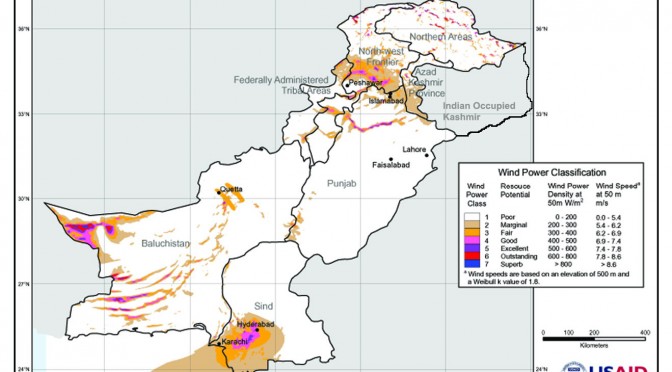“Pakistan has the potential of producing approximately 150,000 MW of power from wind energy sources,” Mr. Shah Faisal Afridi, President Pak-China Joint Chamber of Commerce and Industry, said.
While referring to a recent report compiled by United States Agency for International Development (USAID), which adds that the wind projects can fetch an investment of around two billion dollars, Mr. Afridi urged the government to opt for the short-term and quick start up energy projects to curb the prevailing energy crisis that had crippled down the national economy in general and the industrial sector in particular. Citing another study, President PCJCCI informed that the government has planned to achieve up to, 2,500 MW from wind energy by the end of 2015 and from renewable energy resources including 1000 MW from solar, 50,000 MW from hydro (large), 3,100 MW from hydro (small), 1,800 MW from biogases cogeneration and 500 MW from waste. But, he expressed deep apprehension over the government decisions to opt for the long term energy projects despite knowing that the energy, especially electricity crisis had emerges as the villain of Pakistan’s industrial production.
“The shortfall is causing “a serious setback to the industrial sector and the industrialization process, as well” said Afridi. Energy mix in Pakistan is quite imbalance in comparison to other countries, with greater reliance on non-renewable resources of gas (43.7 %) and oil (29 % – majority of which is imported), therefore; a rational energy mix planning ought to be developed giving greater dependency to renewable (hydel power), indigenous (coal) and Wind energy resources, said Afridi. He explicated that, China faced even higher energy shortages than Pakistan as its economy grew at a very rapid pace, but China compensated the power deficit by exploring awesome wind power capacity in less than eight years. The Chinese continued multiplying its wind power capacities, adding over 6,000 MW in 2008, 12,000 MW in 2009 and 20,000 MW in 2014. They exploited every wind corridor easily accessible in China and are now targeting difficult terrains, he added. In other words, the Chinese only through wind power have added three times more power generation capacity than the entire power generation capacity of Pakistan.
President PCJCCI, Mr. Shah Faisal Afridi emphasized to generate energy through WIND POWER, as in our neighborhood, China and India have successfully tested this option. China has added 62,000 megawatts since 2001 and India 11,500 MW, he informed adding that the Data based on preliminary site surveys carried out by Alternative Energy Development Board (AEDB) and Pakistan Meteorological Department have indicated that, coastal areas of Sindh and Baluchistan provinces and some northern areas possess adequate wind resources. “The official reports identify that in Sindh Province, district Thatta, Karachi, Hyderabad and Badin and in Balochistan Province, district Gwadar and Makran Coastal Belt possesses prospective sites for development, installation and commissioning of wind farm projects”, he asserted. Moreover “Official documents reveal that the wind power potential in the coastal belt of Sindh and Baluchistan is more than 50,000 MW, while Punjab at Kalar Kahar has a wind corridor capable of producing 1,000 MW” added Afridi.
Afridi explicated that, wind turbines projects are relatively fast to install, however, dams and nuclear plants take five to six years to complete and thermal power plants need two years at least, whereas, the wind power plants can be installed in shortest period of 12 to 18 months and the major cost is just the price of land. The running cost of these power generation plants is almost zero as they are run on wind.
Knowing the growing energy requirement of the country, and depleting energy resource within the country, the government of Pakistan deems to diversify its energy mix so that dependency over imported fuel may be reduced and some percentages of power requirement may be met through indigenously available energy technologies. Current government plans to achieve up to 2,500 MW from wind energy by the end of 2015 because Wind energy is sustainable, clean, safe, and economically competitive, stated Afridi.


